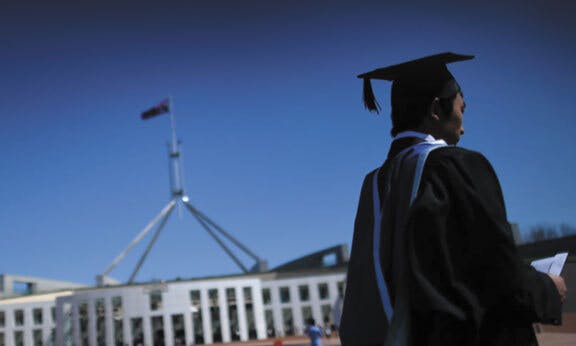$100,000 degrees still on the Liberal agenda

The Turnbull government wants to slash university funding by at least 20 percent and to introduce a revamped version of Christopher Pyne’s notorious 2014 plan to deregulate university fees.
The full extent of the Liberals’ education cuts won’t be known until the May budget is released, but we do know that the government intends to shift the cost of education further on to students.
Education minister Simon Birmingham has stated that deregulation was never off the table, only deferred. The government is also considering ways to recover student debt sooner by lowering – from around $54,000 to $42,000 – the amount a student needs to earn before they must begin repayments. It has also floated the idea of recovering student debt from deceased estates.
While these suggestions indicate the cravenness of the Liberals’ assault on education and their commitment to making students pay, neither will deliver the government its ultimate aim: a rapid privatisation of higher education and a US-style university system.
Recovering HELP-HECS debt from the dead would net the government around $800 million a year. But deregulation – lifting the caps on what universities are allowed to charge for their degrees – would generate billions of dollars for those institutions.
For students, deregulation will mean fee increases, a debt plague and reduced access to university for those from working class families.
For years, Australian universities have been underfunded. Despite Birmingham’s rhetoric about unsustainable growth in government spending on education, which he claims has outpaced economic growth over the past 20 years, the fact is that student numbers have grown over the past few decades without any attendant increase in government funding per student place.
Commonwealth funding per student has actually decreased by more than 10 percent since the late 1990s. The growth in total government expenditure on education that Birmingham bemoans is a result of higher student numbers, encouraged by successive governments’ drive to boost productivity and profits by increasing the number of skilled graduates on offer to employers.
In the 1980s, direct government funding, or “base funding”, constituted 90 percent of all university revenue. Today, after years of neoliberal economic restructuring of higher education, government funding makes up around 40 percent.
The funding shortfall has been made up by university administrations charging international students exorbitant fees and through HELP-HECS hikes for domestic students. As the OECD pointed out in its 2015 “Education at a glance” report, Australian students already pay some of the highest fees in the world. Only in places such as the United States and the UK, where government attacks similar to the ones being proposed by the Liberal government have already been carried out, are fees higher.
National Tertiary Education Union research on the expected cost of deregulated degrees estimates fee increases of 27.5 percent on average just to maintain current funding levels for course delivery – $100,000 degrees for some disciplines and at the more prestigious universities would be a reality.
Fee deregulation would entrench the trend towards a two-tier education system. In a deregulated fee system, the “sandstone” universities would justify increases with reference to their high international rankings and the promise of the social status a qualification from their institution would confer on graduates.
This would make places at Melbourne University or the University of Sydney even more the preserve of the rich, just like the Ivy League colleges in the United States, with poorer students increasingly limited to courses offered by less resourced institutions.
The overall result of deregulation would be fewer choices and a substandard education for the majority. The added impact of government defunding will mean greater staff and course cuts as institutions, especially the second tier ones, scramble to compete for revenue.
In an increasingly deregulated, for-profit system, universities have an interest in offering only the courses with the highest demand and low running costs. This tendency is already reflected in moves by universities over the past decade to cut humanities programs in preference for money-spinning degrees sold to international students, such as commerce and business.
If the Liberals have their way, students can also expect to be locked into a lifetime of crippling debt. This month, the Parliamentary Budget Office released projections showing that the total value of HELP loans, or student debt owed to the government, would soar from the current $42.3 billion to $185.2 billion by 2026.
Birmingham has cynically seized on these statistics as proof that there is a dire need for budget cuts to rein in an education spending “blowout”. He told the media: “There is no point believing that just by racking up ever increasing debts today, that somehow Australians down the track will miraculously be able to pay for them”.
However, the report highlighted that, other than increased student numbers, the greatest contributing factor for rising student debt would be the planned cuts to university funding first floated in Tony Abbott’s 2014 budget and the deregulation of course fees leading to students needing to take out bigger loans that would take even longer to pay off.
For two years, only strident student opposition and protest, backed by the unpopularity of federal budget cuts, have held deregulation at bay. With deregulated fees the centrepiece of the privatised, user-pays higher education industry the Liberals dream of, only a concerted fightback can defeat their agenda.